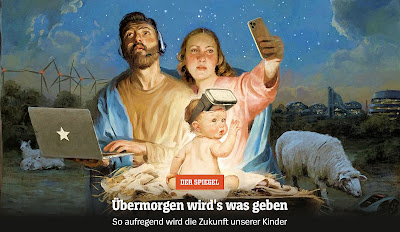Is Freiburg at the Origin of the Christmas Tree?
Fakes are nothing new. Here is a steel engraving from 1843 by
Carl August Schwerdgeburth
(1785-1878) titled "
Dr. Martin Luther im Kreise seiner Familie zu Wittenberg am Christabend
1536" (Dr. Martin Luther surrounded by his family in Wittenberg on Christmas Eve,
1536). The person watching the scene behind the chair clearly is
Philip Melanchthon, Luther's expert on Old Greek and more; the two old people can't be Luther's
parents because they were dead by then.
Luther ought to have said, "If I knew that the world ended tomorrow, I
still would plant an apple tree today." Since I am convinced he would not have
cut down a small fir tree, the candled Christmas tree in Luther's parlor is a
fake. On the other hand, does Luther accompany his ten-year-old son Johannes on
the lute singing his father's popular Christmas carol, "
Vom Himmel hoch, da komm ich her" (From heaven above I come)?
This does not mean that Christmas
parlors at Luther's time had to do without evergreen ornaments. According to a
legend from the Breisgau, the
Brotherhood of Bakers in Freiburg decorated a tree (fir?) with
gingerbread, apples, paper, and colored nuts as early as 1419.
Historical is a document from Strasbourg in 1492 describing the
purchase of fir trees, "
Item Koüfft 9 Tannen in die 9 Kirchspill, das gut jor darjnn zu empfohlen,
unnd darumb gebenn 2 Gulden
(Alike bought 9 fir trees for 9 parishes entrusted for a good year and gave for
them 9 gilders)."
Another historical evidence is from 1521,
when the forester in Schlettstadt (Sélestat), Alsace, was paid to tend the
meyen.
Meyen is a term for the festive tree decorated at Christmas
but with no lights. It was not until 1611 that Duchess
Dorothea Sibyl of Brandenburg
first decorated a Christmas tree with candles.
In bourgeois circles,
the Christmas tree came into vogue only in the late 18th century. Goethe
frequently writes about Christmas trees and how he cut down a fir tree in his
prince's forest. That was a forest crime, severely punished at
the time.
Christmas in Freiburg‘s Minster Church

|
|
The church is decorated with LED-illuminated fir trees
|
Between the solemnities of the Nativity and the Epiphany of the Lord, the
interior of the Freiburg's Minster church is quiet and mostly empty except for
those …

|
|
Admire the splendid Poinsettia (in German
Weihnachtsstern > Christmas Star)
|
… who want to donate a candle to the church's patron saint, St. Mary, …

|
|
A girl and a boy with their rose and bluebonnets
|
… and those who admire the large crib.
Germany's Two Churches on Corona
The Bishop of the Lutheran Church in Central Germany,
Friedrich Kramer, expressed concern about the sharpness of the controversy over Corona
vaccinations. "Vaccination and the debate about it have taken on a religious
character. The absoluteness of the statements reminds me of articles of
faith, "complained the leading clergyman. "Don't judge people solely by
their vaccination status. If you start lumping people together only by what
they say, think, or do, you remain in witch-hunt mode." So we must love
the anti-vaxxers, too.
The Catholic Bishop of Fulda,
Michael Gerber, said that the effect of the pandemic seems to be in everyone's pores and
deviated into some lateral thinking, "Who has what access to what resources
in our world? What interests and power games are involved?". But then he
returned, renewing his call for vaccination. "Those who travel in the cold
fog without appropriate clothing endanger their own health, and those who
drive without headlights also endanger others, " Gerber stressed. He
continued, "Preventive, protective measures and, in particular, vaccination
could be understood as an act of gratitude to God. After all, he gave us the
mind to investigate causes and avert dangers," In the end,
Gerber emphasized: "Trusting in God does not simply replace trusting in
medicine." What a statement.
Is Neil deGrasse Tyson Destroying America's Christmas
Magic?
My loyal readers know that I admire astrophysicist
Neil deGrasse Tyson. However, on Christmas Eve, he seemed to have gone too far with his
country fellows:
Admittedly, for most Europeans, red-dressed Santas*, sleighs with
jingle bells, and red-nose reindeer have little significance
(
Stellenwert).
*We have our St. Nikolaus on December 6
An American reader noted that the timing was horrible, "This is why
people don't like atheists. You post this on Christmas Eve?"
"I like that you give us the physics, but maybe, just once in a while,
you should stop for the holiday magic," wrote another.
Tyson doubled on Christmas Day on zoology and gender madness, "Santa's
reindeer, which all sports antlers, are therefore all female, which means
Rudolf has been misgendered."
A reader commented, "Ruining Christmas one tweet at a time." Another wrote,
"They also can't fly, but you go ahead and take the joy out of everything on
Christmas Eve if it makes you happy."
Sorry, I still like the guy.
*




















































